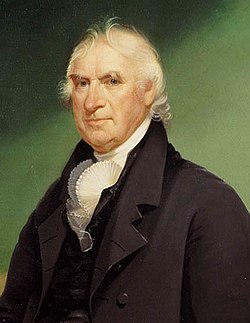| 9th United States Congress | |
|---|---|
8th ← → 10th | |
 United States Capitol (1800) | |
March 4, 1805 – March 4, 1807 | |
| Members | 34 senators 142 representatives 3 non-voting delegates |
| Senate majority | Democratic-Republican |
| Senate President | George Clinton (DR) |
| House majority | Democratic-Republican |
| House Speaker | Nathaniel Macon (DR) |
| Sessions | |
| Special [a] : March 4, 1805 – March 4, 1805 1st: December 2, 1805 – April 21, 1806 2nd: December 1, 1806 – March 4, 1807 | |
The 9th United States Congress was a meeting of the legislative branch of the United States federal government, consisting of the United States Senate and the United States House of Representatives. It met in Washington, D.C., from March 4, 1805, to March 4, 1807, during the fifth and sixth years of Thomas Jefferson's presidency. The apportionment of seats in the House of Representatives was based on the 1800 United States census. Both chambers had a Democratic-Republican majority.
Contents
- Major events
- Major legislation
- Territories organized
- Party summary
- Senate
- House of Representatives
- Leadership
- Senate 2
- House of Representatives 2
- Members
- Senate 3
- House of Representatives 3
- Changes in membership
- Senate 4
- House of Representatives 4
- Committees
- Senate 5
- House of Representatives 5
- Joint committees
- Employees
- Legislative branch agency directors
- Senate 6
- House of Representatives 6
- See also
- Notes
- References
- External links




